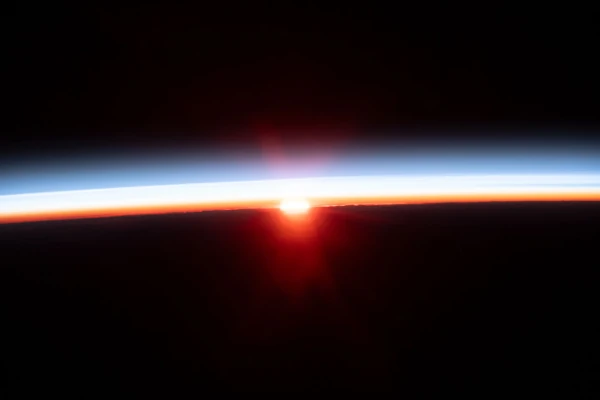
Image: This image of the sun setting over Earth's horizon was taken on July 29, 2009, by the STS-127 crew orbiting Earth in the Space Shuttle Endeavor.
Image Credit: NASA
The times of the day are defined according to the rotation of the Earth on its axis in relation to the position of the Sun in the sky. Times of day play an important role in our perception of time and influence our daily activities.
A day is divided into 24 hours (86,400 s), from zero hour to midnight or into two times twelve hours. This is the time it seems to take for the Sun to go around the Earth. This explains the variations in light and temperature throughout times of the day.
* It should be noted that the durations of the times of the day depend mainly on the altitude and the season of the year. For example, sunset lasts about 24 minutes at the equator, while the Sun does not set at all from March 20 to September 22 at the north pole and does not rise at all from September 23 to March 20.
Dawn is the moment between night and day. This is the period when the sky begins to slowly light up in the east, but the Sun is not yet visible, it is 18° below the horizon in the morning. The sky then takes on a pale blue or gray tint, and a soft, perceptible glow appears. It is caused by the scattering of sunlight in the Earth's atmosphere.
When the Sun is 6° below the horizon, the brightest stars and planets are still visible and will gradually disappear. Dawn also designates the morning twilight.
Dawn lasts on average 68 minutes but this depends on your geographic location and the time of year.
The aurora designates the time of day when the upper edge of the solar disk appears on the eastern horizon. It is a transitional moment between dawn and sunrise but the Sun is not yet visible on the horizon. The sky then takes on a reddish or orange tint.
Refraction causes the edge of the sun's disk to appear above the horizon about 1 minute before the sun is actually visible.
Dawn, aurora and dusk are bright meteors caused by the refraction of light.
Sunrise is the moment when the solar disk appears on the eastern horizon for an observer located on the surface of the earth. This moment ends when the entire solar disk is visible.
Sunrise lasts about 12 minutes at the equator. The duration of sunrise at the poles depends on the season. At the North Pole, it does not rise at all for six months, from September 23 to March 20.
The morning is a word designating the part of the day located between sunrise and noon. The height of the Sun gradually increases in the sky as the Earth continues to rotate, light intensity and temperatures also increase.
The length of the morning is on average half the period between sunrise and sunset, i.e. approximately 6 hours. However, morning length can vary depending on latitude and season. In fact, the length of daylight is longer in summer than in winter. The morning is therefore longer in summer than in winter.
noon is the time when the Sun reaches its highest point in the sky, closest to the zenith. It is the moment opposite solar midnight, when it is closest to the nadir (opposite to the zenith). This is when the shadow of any object is shortest. Noon and 12 o'clock do not coincide in a given place because the time of the Sun advances or delays throughout the year by up to 16 minutes compared to a regular average time.
Theafternoonis the time when the Sun begins to descend from its daytime peak, between noon and evening. During the afternoon, the sun moves from the zenith towards the west, the light intensity then gradually decreases. The afternoon generally ends at 5 p.m. although this is not a standard definition.
Sunset is the time when the solar disk begins to disappear below the western horizon. The day then gives way to evening twilight.
Sunset lasts about 24 minutes at the equator. At the North Pole, the sun does not set at all from March 20 to September 22.
Evening twilight is the time after sunset when the western sky still remains slightly illuminated. Twilight ends when the sky becomes dark, the stars and the Moon become more and more visible. Evening twilight is the time of day between sunset and night.
The duration of evening twilight depends on latitude and season. On average, evening twilight lasts about 60 minutes.
The evening is the period of time immediately following evening twilight. This is the period when the sky darkens further, marking the transition to night. Initially evening meant the last sunny quarter of the day. It happens that in winter, the evening begins around 4:30 p.m. and lasts, in summer, until 9:30 p.m. However, the start of the time of day referred to as evening differs from one country to another taking into account the geography of the globe and the seasons.
night designates the period between the end of evening twilight and the beginning of dawn. During this period, the sky is dark, and the stars, Moon and planets are clearly visible when the sky is clear of clouds.
On average, the duration of the night is 12 hours, however, it can vary from 6 to 24 hours depending on latitude and season.